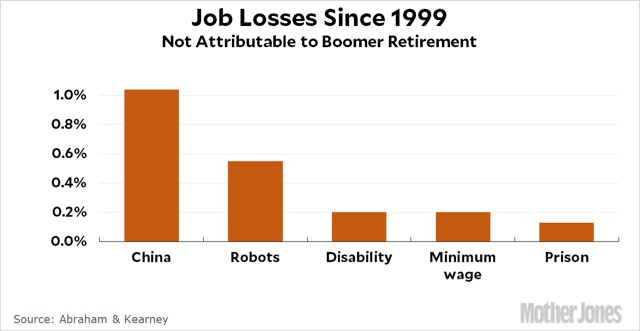China, not automation, is by far the biggest factor in the decline of prime age labor force participation Perhaps the biggest mystery in economic analysis in the last few years has been trying to find an explanation for the big decline in labor force participation since 1999. A recent NBER working paper by Abraham and Kearney has posited the most comprehensive answer to date. Since it was summarized in this Washington Post article, I’m just going to quote a few paragraphs and suggest that you read the entire article. The share of Americans with jobs dropped 4.5 percentage points from 1999 to 2016 — amounting to about 11.4 million fewer workers in 2016. At least half of that decline probably was due to an aging population. Explaining the remainder has
Topics:
NewDealdemocrat considers the following as important: politics, Taxes/regulation, US/Global Economics
This could be interesting, too:
Robert Skidelsky writes Lord Skidelsky to ask His Majesty’s Government what is their policy with regard to the Ukraine war following the new policy of the government of the United States of America.
Joel Eissenberg writes No Invading Allies Act
Ken Melvin writes A Developed Taste
Bill Haskell writes The North American Automobile Industry Waits for Trump and the Gov. to Act
China, not automation, is by far the biggest factor in the decline of prime age labor force participation
The share of Americans with jobs dropped 4.5 percentage points from 1999 to 2016 — amounting to about 11.4 million fewer workers in 2016.
At least half of that decline probably was due to an aging population. Explaining the remainder has been the inspiration for much of the economic research published after the Great Recession.
University of Maryland economists Katharine Abraham and Melissa Kearney built [a method to arrive at a detailed analysis of the data]. After reviewing the most robust research available and doing some rough-but-rigorous math to estimate how much job loss each phenomenon can explain, the duo discovered something surprising: pretty much all the missing jobs are accounted for.
Just as important, they pinpointed the culprits. In a draft paper released by the National Bureau for Economic Research this week, Abraham and Kearney find that trade with China and the rise of robots are to blame for millions of the missing jobs.
China’s accession to the World Trade Organization in 2001 and its subsequent rise to the top of the global export market.

